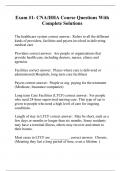Samenvatting
Summary Consulting Methods (Flawless Consulting ) - Grade: 8
An in-depth summary of all the chapters (except 11,18,19) of the book Flawless Consulting from Peter Block and summary of the guest lectures. Discussing all the definitions, frameworks, guidelines, steps in certain phases of consulting, etc. you need to know for the exam. Achieved grade: 8
[Meer zien]














